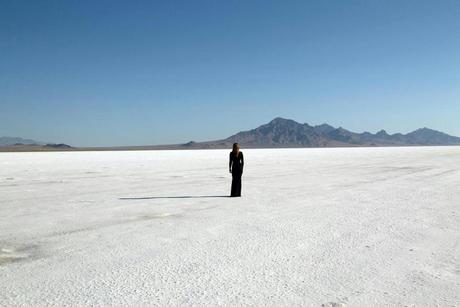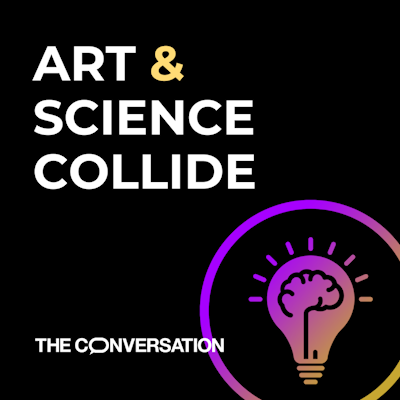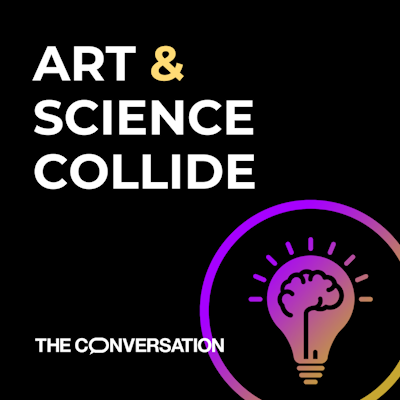
As an artist who works in different media, I have used everything from thread to my voice to poetically translate and express information. Recently I've been working with a different medium: geological datasets.
While scientists use data visualization to display the results of a dataset in interesting and informative ways, my goal as an artist is a little different. In the studio I treat geological data as another material and use it to guide my interactions with Mylar film, knitting patterns or opera. Data functions in my work expressively and abstractly.
Two of my projects in particular, 'points of rupture' and 'tidal arias', are examples of this way of working. In these pieces, my goal is to offer people new ways to personally relate to the immense scope of geological time.
Points of rupture
An early project in which I treated data as a medium was my letterpress series 'points of rupture'. In this series I coded cryoseismic, or icequake, data to create knitting patterns.
Working with icequake data was a continuation of my research into what I call 'archived landscapes'. These are places that have had multiple different geological identities over time, such as mountains that were once marine reefs.
Because knits consist of many individual stitches, I can use them to encode discrete data points. In a knitting pattern or knitting pattern, each type of stitch is represented by a specific symbol. I used the open source program Stitch Maps to write the patterns for this project, translating the peaks and valleys of seismographs into individual stitch symbols.
Knitting cards usually display these symbols in a grid. Instead, Stitch Maps drops them as they would when knitting, so that the diagram mimics the shape of the final textile.
I was drawn to the expressive possibilities of this feature and how the software allowed me to experiment. I could write patterns that only worked in theory and not as physical, handmade structures. This gave me more freedom to design patterns that fully expressed the data sets, without having to guarantee their viability as textiles.
The story continues
Glaciers form incrementally as new snowfall compacts previous snow layers and crystallizes into ice. A knitted fabric stacks up in layers in the same way, like rows of interlocking loops. Each structure appears stable, but can be easily solved.
Icequakes occur in glaciers due to calving events or the collection of meltwater. Like melting glaciers, knitting is always in danger of falling apart - but instead of melting, it snags and unravels into formlessness. These structural similarities between glaciers and knitting are reflected in the 'points of breakture' prints, where disruptive icequakes translate into non-adaptive patterns.
The loop
Repeated, interlocking loops are the basic units that form the structure of a knitted textile. The loop also forms the seed of an ongoing work I pursued during an artist residency at the NASA GEODES research group. I joined their research team in Flagstaff, Arizona in August 2023. I assisted in collecting data from sites in the San Francisco volcanic field, while also conducting my own fieldwork: photography, drawing, note-taking, and hiking.
One of my hikes was a trek around a particularly prominent geological loop: the rim of the SP cinder cone volcano. This is the second crater walk I have completed, the first being a trace of the subterranean rim of the Decorah impact structure in Iowa.
I see my paths through these landscapes as stand-ins for yarn. By taking walks that follow craters or geological loops, I will perform a textile over time. The execution of something as familiar as textiles offers me a new way to think about something much more difficult to understand: geological time.


Literature inspired my medical career: why the humanities are needed in healthcare
I Wrote a Play for Kids About Integrating Arts into STEM Fields - Here's What I Learned About Interdisciplinary Thinking
Art and science intertwined: This course explores the long, interconnected history of two ways of seeing the world
Achievements and Tides
Performance has been a useful tool in my work because it can help people understand and relate to geological processes.
The field of geology emerges from a long history of extraction and colonialist ventures. In this context, land is valued for its economic importance - as a resource to be extracted or as territory to be claimed. In my representations I strive to deal with geology as its own active entity, and not as a consumable resource.
In recent years I have composed and performed two arias based on tidal data.
The first, 'Marseille tide gauge aria', was based on 130 years of sea level data collected at a tide gauge in the Bay of Marseille, France. I converted each annual mean sea level into an individual note within my vocal range. This resulted in a composition that expresses the rising sea level of the bay as increasingly higher notes in the aria.
The text comes from a somber poem in the book 'Songs From the Black Moon' by Rasu-Yong Tugen. Each note of the aria communicates not only the measured sea level, but also my emotional response to this data set.
Last fall, the "Marseille tide meter aria" was broadcast to the ionosphere, the boundary between Earth's atmosphere and space. This was done as part of artist Amanda Dawn Christie's 'Ghosts in the Air Glow' project, using the High-frequency Active Auroral Research Program's ionospheric research instrument, an array of 180 antennas that emit high-frequency radio waves.
The aria's transmission reverberated through the ionosphere, back to Earth and to shortwave radio listeners around the world.
For the second of these vocal pieces, 'skagway tidal aria', I used both predictive and recorded tidal data from Skagway, Alaska. With this data I composed an aria for the 2051 Munich Climate Conference, where speakers presented from the perspective of a climate-changed world thirty years in the future.
I was drawn to this particular data set because the declining tide levels in Skagway appear to contradict the global trend of rising sea levels. However, this is a temporary effect caused by melting glaciers removing pressure on the land, allowing it to rise faster than water levels. The effect will level off over the next half century and tides in Skagway will start rising again.
Over the coming months I will be working with geophysical datasets collected during the NASA GEODES field expedition to write new arias. I want these pieces to continue to blur the lines between the human and the geological, inviting listeners to think more deeply about their own relationships with the lands they use and occupy.
This article is republished from The Conversation, an independent nonprofit organization providing facts and analysis to help you understand our complex world.It was written by: Sarah Nance, Binghamton University, State University of New York.
Read more: The author's projects with GEODES and Ghosts in the Air Glow were supported with funding from these organizations.